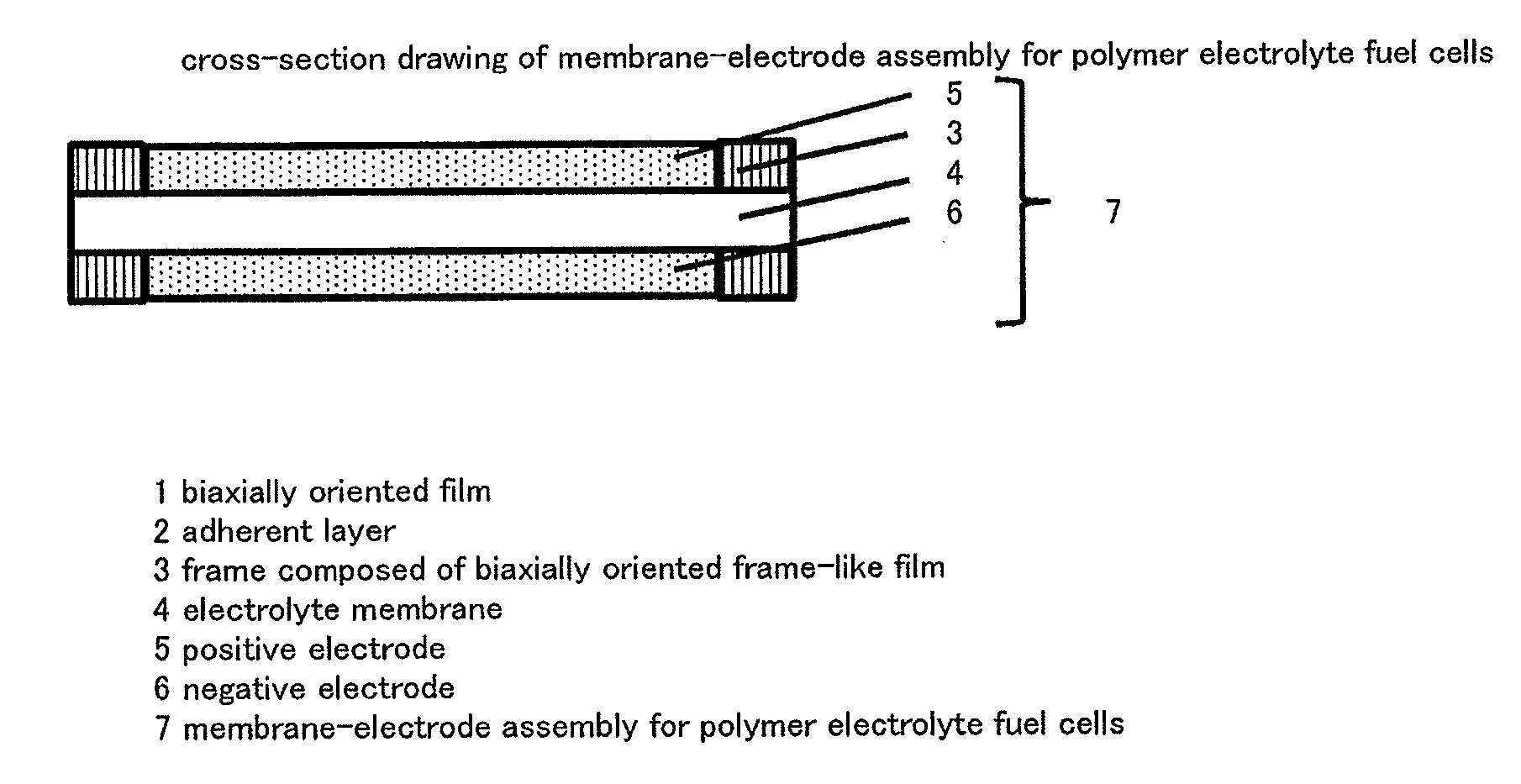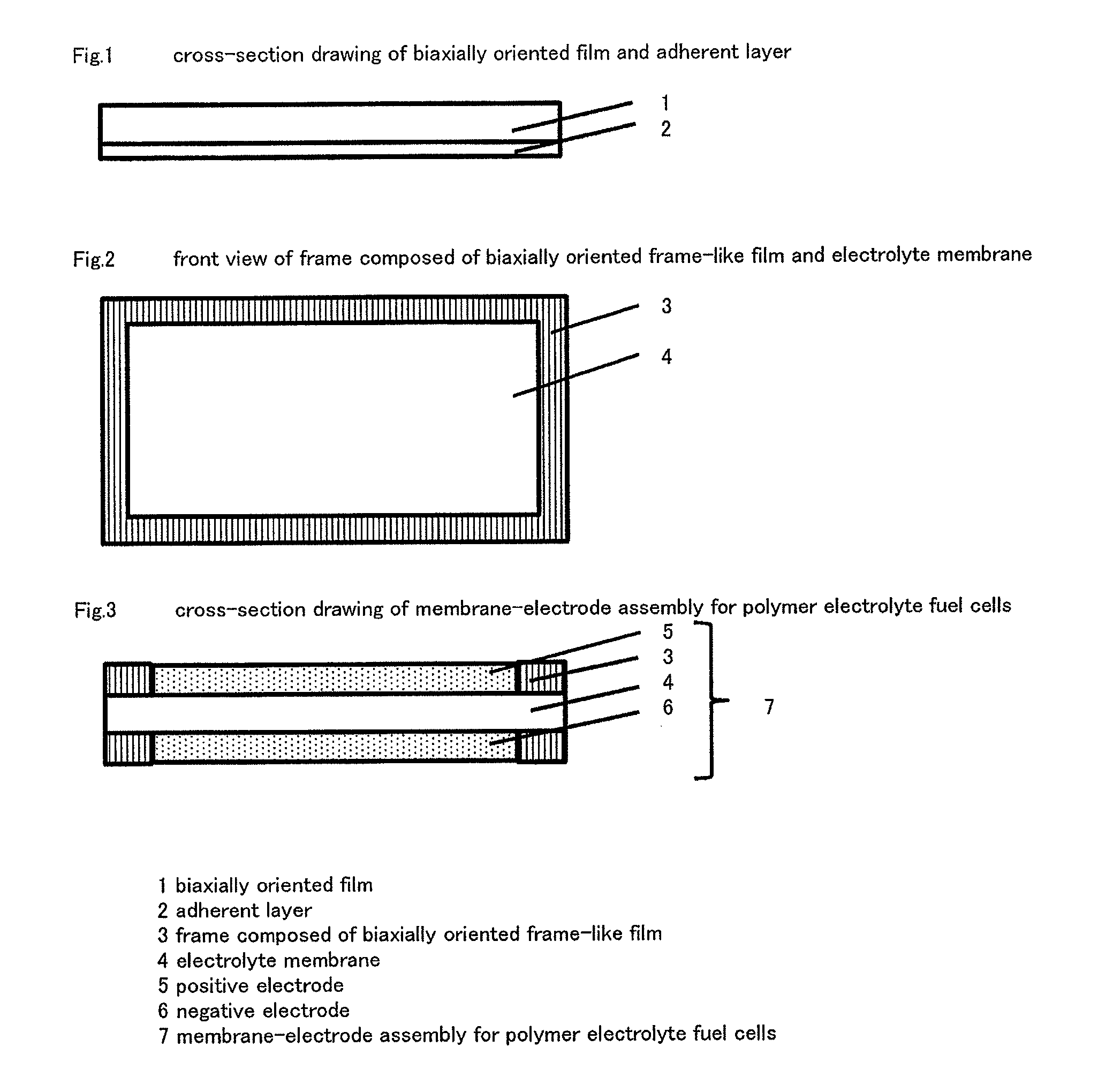Reinforcing film for the electrolyte membrane of a polymer electrolyte fuel cell
a fuel cell and electrolyte technology, applied in the direction of cell components, cell component details, electrochemical generators, etc., can solve the problems of poor mechanical strength, degraded reinforcing effect, and difficult to handle this polymer electrolyte membrane, and achieve excellent heat-resistant dimensional stability, high hydrolysis resistance, and good mechanical strength.
- Summary
- Abstract
- Description
- Claims
- Application Information
AI Technical Summary
Benefits of technology
Problems solved by technology
Method used
Image
Examples
example 1
100 Parts by Weight of Dimethyl
[0100]2,6-naphthalenedicarboxylate, 60 parts by weight of ethylene glycol, 0.03 part by weight of manganese acetate tetrahydrate as an ester interchange catalyst, 0.10 wt % of spherical silica particles having an average particle diameter of 0.3 and 0.15 wt % of spherical silica particles having an average particle diameter of 0.12 μm as lubricants were added to carry out an ester interchange reaction in accordance with a commonly used method. The amounts of the lubricants are based on the weight of the film. Thereafter, 0.042 part by weight of triethyl phosphonoacetate was added to terminate the ester interchange reaction substantially. Then, 0.024 part by weight of antimony trioxide was added to carry out a polymerization reaction in a high-temperature high-vacuum atmosphere in accordance with a commonly used method so as to obtain polyethylene-2,6-naphthalene dicarboxylate (PEN, Tg=121° C.) having an intrinsic viscosity of 0.60 dl / g. This PEN polyme...
example 2
[0102]A biaxially oriented film having a thickness of 38 μm was obtained in the same manner as in Example 1 except that a coating fluid was not applied to one side of the monoaxially oriented film. The characteristic properties of the obtained film are shown in Table 1. The obtained film had a Young's modulus in the transverse direction of not less than 9,000 MPa and was excellent in hydrolysis resistance and dimensional stability at a high temperature. Further, it was also excellent in the evaluation of the form stability of the electrolyte membrane and the evaluation of the reinforcing performance of the reinforcing member.
example 3
[0103]A biaxially oriented film having a thickness of 38 μm was obtained in the same manner as in Example 1 except that the draw ratio in the longitudinal direction was changed to 3.0 times. The characteristic properties of the obtained film are shown in Table 1. The obtained film had a Young's modulus in the transverse direction of not less than 9,000 MPa and was excellent in hydrolysis resistance and dimensional stability at a high temperature. Further, it was also excellent in adhesion to the electrolyte member as well as the evaluation of the form stability of the electrolyte membrane and the evaluation of the reinforcing performance of the reinforcing member.
PUM
| Property | Measurement | Unit |
|---|---|---|
| Young's modulus | aaaaa | aaaaa |
| heat shrinkage factors | aaaaa | aaaaa |
| rupture elongation at break | aaaaa | aaaaa |
Abstract
Description
Claims
Application Information
 Login to View More
Login to View More - R&D
- Intellectual Property
- Life Sciences
- Materials
- Tech Scout
- Unparalleled Data Quality
- Higher Quality Content
- 60% Fewer Hallucinations
Browse by: Latest US Patents, China's latest patents, Technical Efficacy Thesaurus, Application Domain, Technology Topic, Popular Technical Reports.
© 2025 PatSnap. All rights reserved.Legal|Privacy policy|Modern Slavery Act Transparency Statement|Sitemap|About US| Contact US: help@patsnap.com


